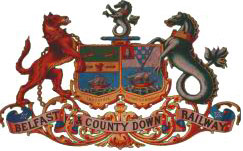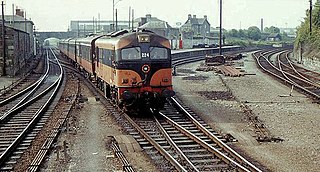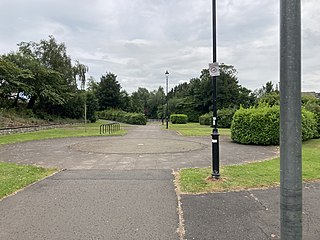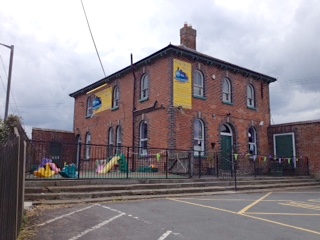
The Ulster Transport Authority (UTA) ran rail and bus transport in Northern Ireland from 1948 until 1966.

The Belfast and County Down Railway (BCDR) was an Irish gauge railway in Ireland linking Belfast with County Down. It was built in the 19th century and absorbed into the Ulster Transport Authority in 1948. All but the line between Belfast and Bangor was closed in the 1950s, although some of it has been restored near Downpatrick by a heritage line, the Downpatrick and County Down Railway.

Dromore is a small market town and civil parish in County Down, Northern Ireland. It lies within the local government district of Armagh City, Banbridge and Craigavon. It is 19 miles (31 km) southwest of Belfast, on the A1 Belfast–Dublin road. The 2011 Census recorded a population of 6,395.

The Great Northern Railway (Ireland) (GNR(I) or GNRI) was an Irish gauge (1,600 mm (5 ft 3 in)) railway company in Ireland. It was formed in 1876 by a merger of the Irish North Western Railway (INW), Northern Railway of Ireland, and Ulster Railway. The governments of Ireland and Northern Ireland jointly nationalised the company in 1953, and the company was liquidated in 1958: assets were split on national lines between the Ulster Transport Authority and Córas Iompair Éireann.

The Belfast–Newry line operates from Lanyon Place station in County Antrim to Newry in County Down, Northern Ireland. The manager for this line is based at Portadown railway station, although the line extends to the border to include the Scarva and Poyntzpass halts and Newry. Newry is on the fringe of the network, being the last stop before the border with the Republic of Ireland. The line follows the route of the northern half of the main Dublin–Belfast line, with the exception of calling at Belfast Great Victoria Street.

Knockmore railway station was a station on the Belfast–Newry railway line. The station served the suburb of Knockmore in Lisburn, County Antrim, Northern Ireland. The Great Northern Railway (GNR) opened Knockmore station as a halt in 1932. Northern Ireland Railways (NIR) closed the station on 25 March 2005.

The Lisburn–Antrim line is a 20-mile (32 km) railway line of Northern Ireland Railways. It links Knockmore Junction on the Belfast–Newry line with Antrim on the Belfast–Derry line. It has been closed to passenger services since 2003.

Banbridge is a town in County Down, Northern Ireland. It lies on the River Bann and the A1 road and is named after a bridge built over the River Bann in 1712. It is situated in the civil parish of Seapatrick and the historic barony of Iveagh Upper, Upper Half. The town began as a coaching stop on the road from Belfast to Dublin and thrived from Irish linen manufacturing. The town was home to the headquarters of the former Banbridge District Council. Following a reform of local government in Northern Ireland in 2015, Banbridge became part of Armagh City, Banbridge and Craigavon Borough Council. It had a population of 17,400 in the 2021 Census.

Dublin and the Belfast Junction Railway was an Irish gauge railway in Ireland. The company was incorporated in 1845 and opened its line in stages between 1849 and 1853, with the final bridge over the River Boyne opening in 1855. It linked the Ulster Railway (UR) from Belfast to Portadown and Dublin and Drogheda Railway (D&D) from Drogheda to Dublin, completing the missing link in the Belfast–Dublin line.

Irish North Western Railway (INW) was an Irish gauge railway company in Ireland.
Northern Railway of Ireland was an Irish gauge 5 ft 3 in railway company in Ireland.
Ulster railways, present and past, include:
The Londonderry and Enniskillen Railway (L&ER) was an Irish gauge railway in Ireland.
The Portadown, Dungannon and Omagh Junction Railway (PD&O) was an Irish gauge railway in County Armagh and County Tyrone, Ulster, Ireland.
The Enniskillen and Bundoran Railway (E&BR) was an Irish gauge 5 ft 3 in railway company in north-west Ireland. It linked Bundoran and Ballyshannon on the Atlantic coast of Donegal with the Londonderry and Enniskillen Railway (L&ER) at Bundoran Junction in Fermanagh. The line was opened in 1868 and closed in 1957.

Trew and Moy railway station was a railway station in County Tyrone, Northern Ireland. The station was near Trew Mount, over 2 miles north of Moy.

Vernersbridge railway station was a railway station in County Armagh, Northern Ireland. The station was about 0.7 miles south of Clonmore and about 0.25 miles east of a substantial viaduct by which the railway crossed the River Blackwater.

Dungannon railway station served Dungannon in County Tyrone in Northern Ireland.

Banbridge railway station was on the Banbridge, Lisburn and Belfast Railway which ran from Knockmore Junction to Banbridge in Northern Ireland.

The Banbridge, Lisburn and Belfast Junction Railway was an Irish gauge railway in Ireland linking Belfast with Banbridge, County Down. It was built in the 19th century. The line between Knockmore and Banbridge was closed in 1956.

















